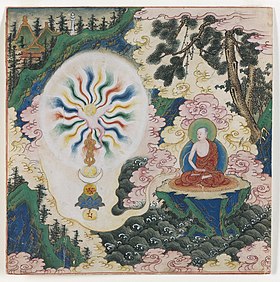Our website is made possible by displaying online advertisements to our visitors.
Please consider supporting us by disabling your ad blocker.
Deity yoga
This article's lead section may be too long. (July 2024) |

| Part of a series on |
| Vajrayana Buddhism |
|---|
 |

The fundamental practice of Vajrayana and Tibetan tantra is deity yoga (devatayoga), meditation on a chosen deity or "cherished divinity" (Skt. Iṣṭa-devatā, Tib. yidam), which involves the recitation of mantras, prayers and visualization of the deity, the associated mandala of the deity's Buddha field, along with consorts and attendant Buddhas and bodhisattvas.[1] According to the Tibetan scholar Tsongkhapa, deity yoga is what separates Tantra from Sutra practice.[2]
In the Unsurpassed Yoga Tantras, the most widespread tantric form in Indo-Tibetan Buddhism, this method is divided into two stages, the generation stage (utpatti-krama) and the completion stage (nispanna-krama). In the generation stage, one dissolves one's reality into emptiness and meditates on the deity-mandala, resulting in identification with this divine reality. In the completion stage, the divine image along with the subtle body is applied to the realization of luminous emptiness.
The Indian tantric scholar Ratnākaraśānti (c. 1000 CE) describes the generation stage cultivation practice thus:
[A]ll phenomenal appearance having arisen as mind, this very mind is [understood to be] produced by a mistake (bhrāntyā), i.e. the appearance of an object where there is no object to be grasped; ascertaining that this is like a dream, in order to abandon this mistake, all appearances of objects that are blue and yellow and so on are abandoned or destroyed (parihṛ-); then, the appearance of the world (viśvapratibhāsa) that is ascertained to be oneself (ātmaniścitta) is seen to be like the stainless sky on an autumn day at noon: appearanceless, unending sheer luminosity.[3]
This dissolution into emptiness is then followed by the visualization of the deity and re-emergence of the yogi as the deity. During the process of deity visualization, the deity is to be imaged as not solid or tangible, as "empty yet apparent," with the character of a mirage or a rainbow. This visualization is to be combined with "divine pride", which is "the thought that one is oneself the deity being visualized."[4] Divine pride is different from common pride because it is based on compassion for others and on an understanding of emptiness.[5]

Following mastery of the "generation stage," one practices the "perfection" or "completion" stage. The Indian commentator Buddhaguhya (c. 700 CE), in his commentary on the Mahavairocana Tantra, outlines the "perfection stage" practices thus:
First you should actualize all the four branches of recitation for a while as before, and then analyze the manifestation of the created (parikalpita) colour, shape, and so on, of your tutelary deity who is identical to yourself, breaking them down into atoms. Or it is also acceptable to do this by way of the reasoning that is unborn and unarising from the very beginning, or similarly by way of the technique of drawing-in the vital energy (prana) through the yoga of turning your mind inside, or by way of not focusing on its appearance [as colour and shape]. In accordance with that realization, you should then actualize the mind which is just self-aware, free from the body image of your tutelary deity and without appearance [as subject and object], and mentally recite your vidya mantra as appropriate.[6]
The Tibetologist David Germano outlines two main types of completion practice: a formless and image-less contemplation on the ultimate empty nature of the mind and various yogas that make use of the subtle body to produce energetic sensations of bliss and warmth.[7]
The subtle body yogas systems like the Six Dharmas of Naropa and the Six Yogas of Kalachakra make use of energetic schemas of human psycho-physiology composed of "energy channels" (Skt. nadi, Tib. rtsa), "winds" or currents (Skt. vayu, Tib. rlung), "drops" or charged particles (Skt. bindu, Tib. thig le) and chakras ("wheels"). These subtle energies are seen as "mounts" for consciousness, the physical component of awareness. They are engaged by various means such as pranayama (breath control) to produce blissful experiences that are then applied to the realization of ultimate reality.[8]
Other methods which are associated with the completion stage in Tibetan Buddhism include dream yoga (which relies on lucid dreaming), practices associated with the bardo (the interim state between death and rebirth), transference of consciousness (phowa) and chöd, in which the yogi ceremonially offers their body to be eaten by all beings in a ritual feast.
- ^ Garson (2004), p. 37.
- ^ Powers (2007), p. 271.
- ^ Tomlinson (2018).
- ^ Cozort (2005), p. 57.
- ^ Powers (2007), p. 273.
- ^ Gray (2007), pp. 72–73.
- ^ Gray (2007), pp. 73–74.
- ^ Garson (2004), p. 45.
Previous Page Next Page


